Question 1.
In △PQR, ST is a line such that PS/SQ=PT/TR and also ∠PST = ∠PRQ.
Prove that △PQR is an isosceles triangle.
Answer:
Given : In △PQR,
PS/SQ=PT/TR and ∠PST= ∠PRQ.
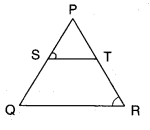
R.T.P: △PQR is isosceles.
Proof: PS/SQ = PT/TR
Hence, ST ∥ QR (Converse of Basic proportionality theorem)
∠PST = ∠PQR .... (1)
(Corresponding angles for the lines ST ∥ QR)
Also, ∠PST = ∠PRQ ... (2) given
From (1) and (2),
∠PQR = ∠PRQ
i.e., PR = PQ
[∵ In a triangle sides opposite to equal angles are equal]
Hence, APQR is an isosceles triangle.
Question 2.
In the given figure, LM ∥ CM and LN ∥ CD. Prove that AMAB = ANAD.
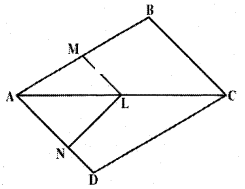
Answer:
Given : LM ∥ CB and LN ∥ CD In △ABC, LM ∥ BC (given) Hence,
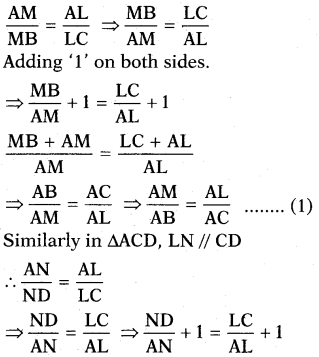
Adding ‘1’ on both sides.

From (1) and (2)
∴ AMAB = ANAD.
Question 3.
In the given figure, DE ∥ AC and DF ∥ AE. Prove that BF/FE = BE/AC.
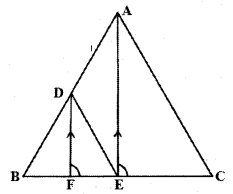
Answer:
In △ABC, DE ∥ AC
Hence BE/EC = BD/DA .... (1)
[∵ A line drawn parallel to one side of a triangle divides the other two sides in the same ratio - Basic proportionality theorem]
Also in △ABE, DF ∥ AE
Hence BF/FE = BD/DA .... (2)
From (1) and (2), BF/FE = BE/AC Hence proved.
Question 4.
Prove that a line drawn through the mid-point of one side of a triangle parallel to another side bisects the third side (Using Basic proportionality theorem).
Answer:
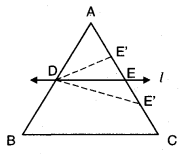
Given: In △ABC; D is the mid-point of AB.
A line ‘l’ through D, parallel to BC, meeting AC at E.
R.T.P: E is the midpoint of AC.
Proof:
DE ∥ BC (Given)
then
AD/DB=AE/EC(From Basic Proportional theorem)
Also given ‘D’ is mid point of AB.
Then AD = DB.
⇒AD/DB=DB/DB=AE/EC= 1
⇒ AE = EC
∴ ‘E’ is mid point of AC

Question 5.
Prove that a line joining the mid points of any two sides of a triangle is parallel to the third side. (Using converse of Basic proportionality theorem)
Answer:
Given: △ABC, D is the midpoint of AB and E is the midpoint of AC.
R.T.P : DE ∥ BC.
Proof:
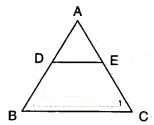
Since D is the midpoint of AB, we have AD = DB ⇒AD/DB= 1 ……. (1)
also ‘E’ is the midpoint of AC, we have AE = EC ⇒AE/EC = 1 ……. (2)
From (1) and (2)
AD/DB=AE/EC
If a line divides any two sides of a triangle in the same ratio then it is parallel to the third side.
∴ DE ∥ BC by Basic proportionality theorem.
Hence proved.
Question 6.
In the given figure, DE ∥ OQ and DF ∥ OR. Show that EF ∥ QR.

Answer:
Given: △PQR, DE ∥ OQ; DF ∥ OR
R.T.P: EF ∥ QR
Proof:
In △POQ;
PEEQ = PDDO ……. (1)
[∵ ED ∥ QO, Basic proportionality theorem]
In △POR;PF/FR = PD/DO ……. (2) [∵ DF ∥ OR, Basic Proportionality Theorem]
From (1) and (2),
PE/EQ=PF/FR

Question 7.
In the given figure A, B and C are points on OP, OQ and OR respec¬tively such that AB ∥ PQ and AC ∥ PR. Show that BC ∥ QR.
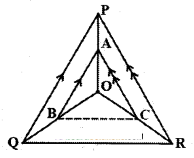
Answer:
Given:
In △PQR, AB ∥ PQ; AC ∥ PR
R.T.P : BC ∥ QR
Proof: In △POQ; AB ∥ PQ
OA/AP=OB/BQ ……… (1)
(∵ Basic Proportional theorem)
and in △OPR, Proof: In △POQ; AB ∥ PQ
OA/AP=OC/CR ……… (2)
From (1) and (2), we can write
OB/BQ=OC/CR
Then consider above condition in △OQR then from (3) it is clear.
∴ BC ∥ QR [∵ from converse of Basic Proportionality Theorem]
Hence proved.
Question 8.
ABCD is a trapezium in which AB ∥ DC and its diagonals intersect each other at point ‘O’. Show that AO/BO = CO/DO.
Answer:
Given: In trapezium □ ABCD, AB ∥ CD. Diagonals AC, BD intersect at O.
R.T.P: AO/BO = CO/DO
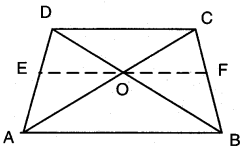
Construction:
Draw a line EF passing through the point ‘O’ and parallel to CD and AB.
Proof: In △ACD, EO ∥ CD
∴AO/CO = AE/DE …….. (1)
[∵ line drawn parallel to one side of a triangle divides other two sides in the same ratio by Basic proportionality theorem]
In △ABD, EO ∥ AB
Hence, DE/AE = DO/BO
[∵ Basic proportionality theorem]
BO/DO = AE/ED …….. (2) [∵ Invertendo]
From (1) and (2),
AO/CO = BO/DO
⇒ AO/BO = CO/DO[∵ Alternendo]
Question 9.
Draw a line segment of length 7.2 cm and divide it in the ratio 5 : 3. Measure the two parts.
Answer:
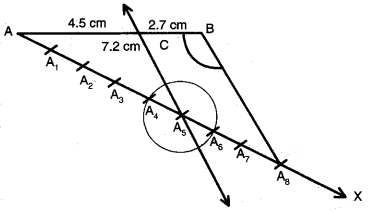
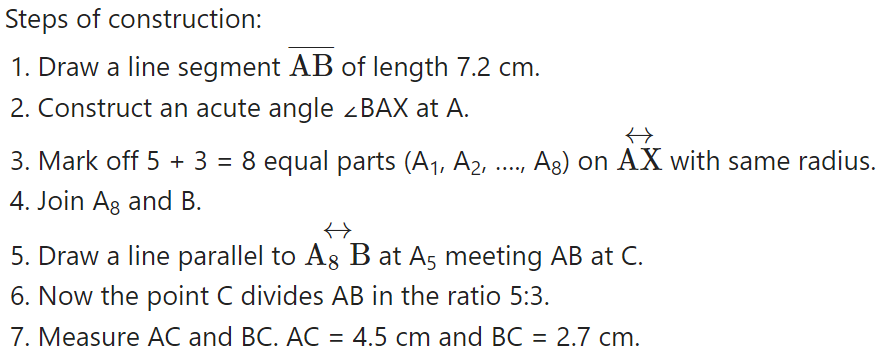
Question 1.
In the given figure, ∠ADE = ∠B
i) Show that △ABC ~ △ADE
ii) If AD = 3.8 cm, AE = 3.6 cm, BE = 2.1 cm, BC = 4.2 cm, find DE.
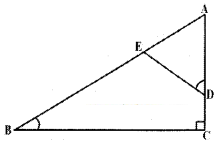
Answer:
i) Given: △ABC and ∠ADE = ∠B
R.T.P: △ABC ~ △ADE.
Proof: In △ABC and △ADE
∠A = ∠A [∵ Common]
∠B = ∠ADE [∵ Given]
∴ ∠C = ∠AED [∵ By Angle Sum property of triangles] △ABC ~ △ADE. by AAA similarity condition.]
ii) AD = 3.8 cm, AE = 3.6 cm, BE = 2.1 cm, BC = 4.2 cm, find DE.
To find DE; △ABC ~ △ADE.
Hence,
AB/AD = BC/DE = AC/AE
[∵ Ratios of corresponding sides are equal]
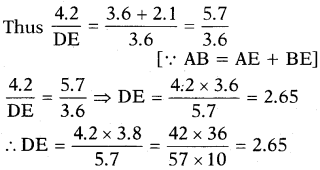
Question 2.
The perimeters of two similar triangles are 30 cm and 20 cm respectively. If one side of the first triangle is 12 cm, determine the corresponding side of the second triangle.
Answer:
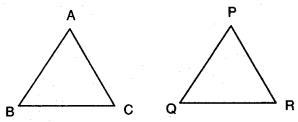
Given: △ABC ~ △PQR
Perimeter of △ABC = 30 cm.
Perimeter of △PQR = 20 cm.
AB = 12 cm.

Question 3.
A girl of height 90 cm is walking away from the base of a lamp-post at a speed of 1.2 m/sec. If the lamp-post is 3.6 m above the ground, find the length of her shadow after 4 seconds.
Answer:
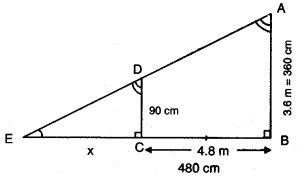

Let the length of the shadow at a distance of 4.8 m from the lamp post = x cm.
From the figure,
△ABE ~ △DCE
[∵ ∠B = ∠C = 90°
∠E = ∠C common
(A.A. similarity)]
Hence,
AB/DC = BE/CE = AE/DE
∴ 360/90 = 480+x/x
⇒ 4 = 480+x/x
⇒ 4x = 480 + x
⇒ 4x - x = 480
⇒ 3x = 480
⇒ x = 160 cm = 1.6 m
∴ Length of the shadow = 1.6 m
Question 4.
CM and RN are respectively the medians of similar triangles △ABC and △PQR. Prove that
i) △AMC ~ △PNR
ii)CM/RN = AB/PQ
iii) △CMB ~ △RNQ

Answer:
Given : △ABC ~ △PQR
CM is a median through C of △ABC.
RN is a median through R of △PQR.
R.T.P:
i) △AMC ~ △PNR.
Proof: In △AMC and △PNR,
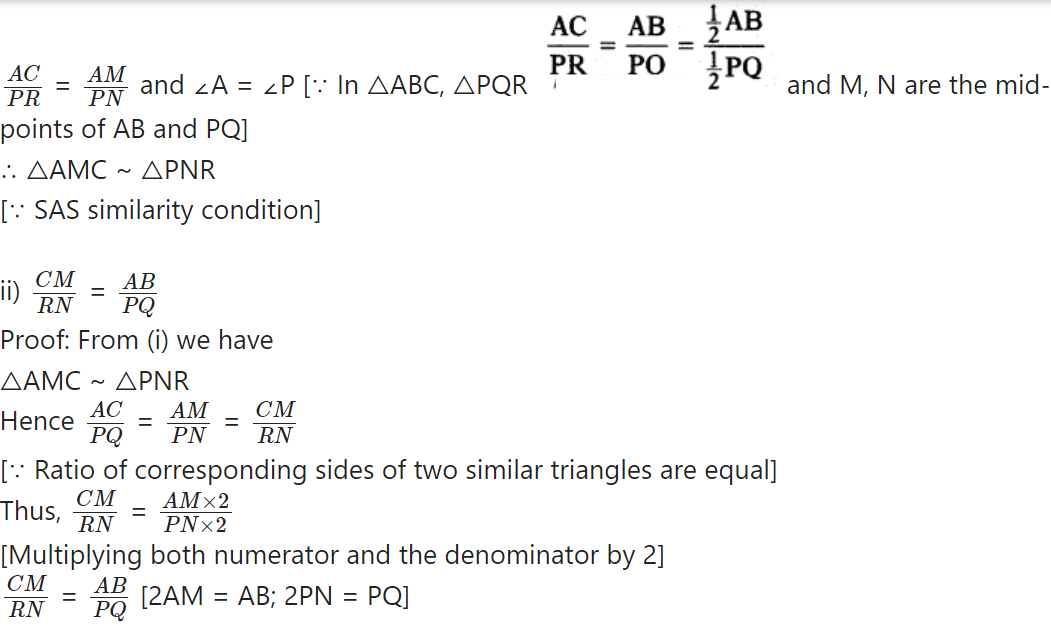
iii) △CMB ~ △RNQ
Proof: In △CMB and △RNQ
∠B = ∠Q [Corresponding angles of △ABC and △PQR]
Also, BC/RQ = BM/QN

Thus, △CMB ~ △RNQ by S.A.S similarity condition.
Question 5.
Diagonals AC and BD of a trapezium ABCD with AB ∥ DC intersect each other at the point ‘O’. Using the criterion of similarity for two triangles, show that OA/OC = OB/OD.
Answer:

Given : □ ABCD, AB ∥ DC
The diagonals AC and BD intersect at ‘O’.
R.T.P: OA/OC = OB/OD
Construction: Draw EF ∥ AB, passing through ‘O’.
Proof: In △ACD, OE ∥ CD [∵ Construction]
Hence OA/OC = EA/ED …….. (1)
(∵ Line drawn parallel to one side of a triangle divides other two sides in the same ratio - Basic proportionality theorem)
Also in △ABD, EO ∥ AB [Construction] Hence,
EA/ED = OB/OD ……… (2)
(∵ Basic proportionality theorem) From (1) and (2), we have
OA/OC = OB/OD
∴ Hence proved.
Question 6.
AB, CD, PQ are perpendicular to BD. AB = x, CD = y and PQ = z, prove that 1/x + 1/y = 1/z.
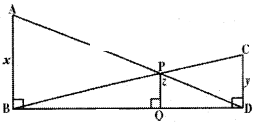
Answer:
Given ∠B = ∠Q = ∠D = 90°
Thus, AB ∥ PQ ∥ CD.
Now in △BQP, △BDC
∠B = ∠B (Common)
∠Q = ∠D (90°)
∠P = ∠C [∵ Angle Sum property of triangles]
∴ △BQP ~ △BDC
(by A.A.A similarity condition)
Hence BQ/BD = PQ/CD
[∵ Ratio of corresponding sides is equal] Also in △DQP and △DBA
∠D = ∠D (Common)
∠Q = ∠B (90°)
∴ △DQP ~ △DBA (by A.A. similarity condition)
QD/BD = PQ/AB
[ Ratio of corresponding sides is equal]
Adding (1) and (2), we get
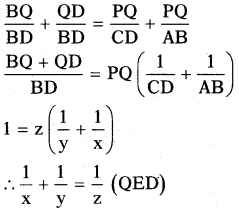
Question 7.
A flag pole 4 m tall casts a 6 m., shadow. At the same time, a nearby building casts a shadow of 24 m. How tall is the building?
Answer:
Given: 4 m length flag pole casts a shadow 6 m.
Let x m length/tall building casts a shadow 24 m.
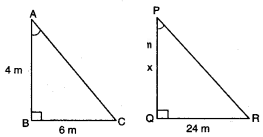
Let AB be the length of flag pole = 4 m.
Shadow of AB = BC = 6 m.
PQ be the building = x m (say)
QR, the shadow of the building = 24 m
From the figure,
∠A = ∠P
∠B = ∠Q
∴ △ABC ~ △PQR by A.A. similarity condition
Hence AB/PQ = BC/QR
[∵ Ratio of corresponding angles is equal]
4/6=x/24
x = 24×4/6= 16 m
∴ Height of the building = 16 m.
Question 8.
CD and GH are respectively the bisectors of ∠ACB and ∠EGF such that D and H lie on sides AB and FE of △ABC and △FEG respectively. If △ABC ~ △FEG then show that
i)CD/GH = AC/FG
ii) △DCB ~ △HGE
iii) △DCA ~ △HGF
Answer:

Given: △ABC ~ △FEG.
CD is the bisector of ∠C and GH is the bisector of ∠G.
R.T.P.:
i)CD/GH = AC/FG
In △ACD and △FGH
∠A = ∠F
[∵ Corresponding angles of △ABC and △FEG]
∠ACD = ∠FGH
[∵ ∠C = ∠G ⇒ 1/2 ∠C = 1/2 ∠G ⇒ ∠ACD = ∠FGH]
∴ By A.A. similarity condition, △ACD ~ △FGH
AC/FG = CD/GH = AD/FH
[∵ Ratio of the Corresponding angles is equal]
⇒ AC/FG = CD/GH [Q.E.D]
ii) △DCB ~ △HGE
In △DCB and △HGE,
∠B = ∠E
[∵ Corresponding angles of △ABC and △FEG]
∠DCB = ∠HGE
[∵ ∠C = ∠G ⇒ 1/2 ∠C =1/2 ∠G ⇒ ∠DCB = ∠HGE]
∴ △DCB ~ △HGE . (by A.A. similarity condition)
iii) △DCA ~ △HGF
In △DCA and △HGF
∠A = ∠F
12∠C = 1/2 ∠G ⇒ ∠DCA = ∠HGF
[∵ Corresponding angles of the similar triangles]
∴ △DCA ~ △HGF
[ A.A. similarity condition]
Question 9.
AX and DY are altitudes of two similar triangles △ABC and △DEF. Prove that AX : DY = AB : DE.
Answer:
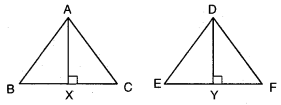
Given: △ABC ~ △DEF.
AX ⊥ BC and DY ⊥ EF.
R.T.P.: AX : DY = AB : DE.
Proof: In △ABX and △DEY ∠B = ∠E [∵ Corresponding angles of △ABC and △DEF]
∠AXB = ∠DYE [given]
∴ △ABX ~ △DEY
(by A.A. similarity condition)
Hence AB/DE = BX/EY = AX/DY
[∵ Ratios of corresponding sides of similar triangles are equal]
⇒ AX : DY = AB : DE [Q.E.D.]
Question 10.
Construct a triangle shadow similar to the given ?ABC, with its sides equal to 5/3 of the corresponding sides of the triangle ABC.
Answer:
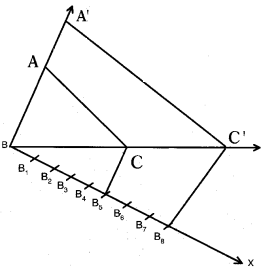
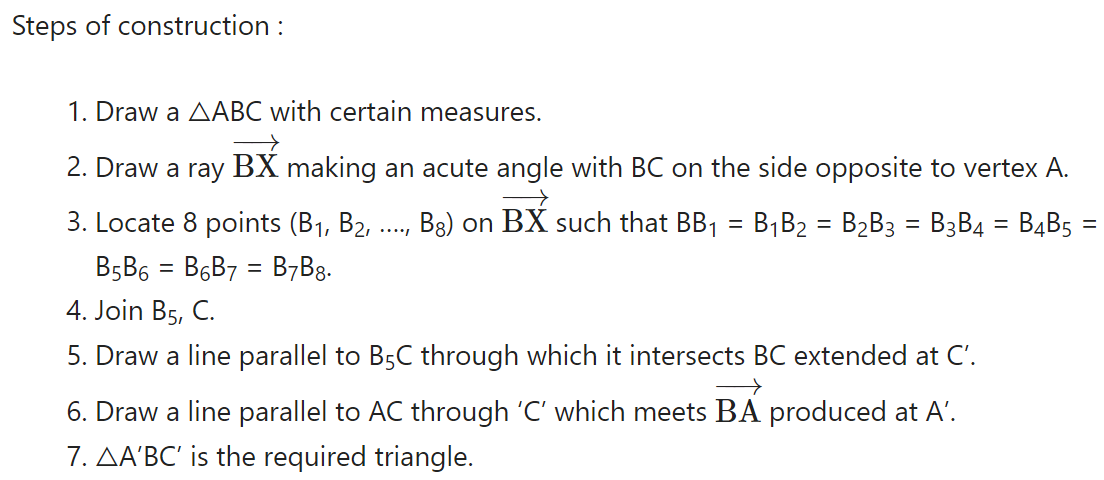
Question 11.
Construct a triangle of sides 4 cm, 5 cm and 6 cm. Then, construct a triangle similar to it,whose sides are 2/3 of the corresponding sides of the first triangle.
Answer:
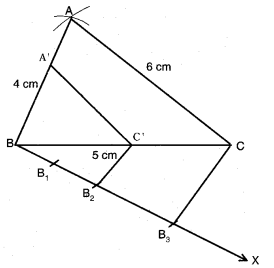
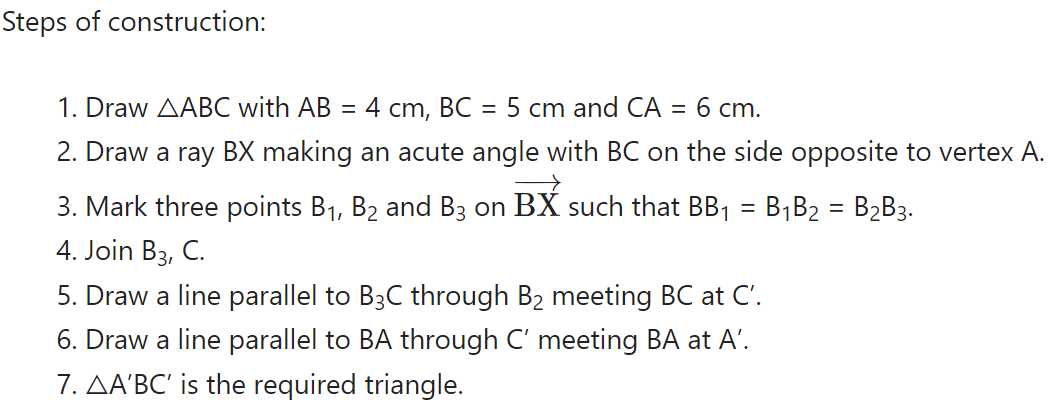
Question 12.
Construct an isosceles triangle whose base is 8 cm and altitude is 4 cm. Then, draw another triangle whose sides are 1 1/2 times the corresponding sides of the isosceles triangle.
Answer:
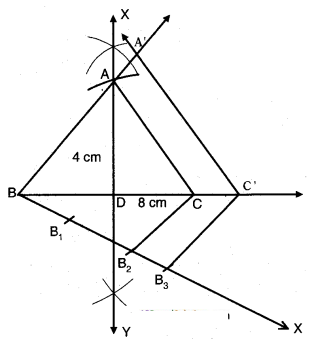
Steps of construction:
- Draw AABC in which BC = 8 cm and altitude AD = 4 cm.
- Draw a ray BX making an acute angle with BC on the side opposite to vertex A.
- Mark three points B1, B2and B3such that BB1= B1B2= B2B3.
- Join B2C.
- Draw a line parallel to B2C through B3meeting BC produced C’.
- Draw a line paral1e1 to AC through C’ meeting BA produced at A’.
- △A’BC’ is the required triangle.
Question 1.
Equilateral triangles are drawn on the three sides of a right angled triangle. Show that the area of the triangle on the hypotenuse is equal to the sum of the areas of triangles on the other two sides.
Answer:
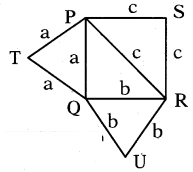
Let △PQR is a right angled triangle, ∠Q = 90°
Let PQ = a, QR b and
PR = hypotenuse = c
Then from Pythagoras theorem we can
say a2+ b2= c2……… (1)
△PSR is an equilateral triangle drawn on hypotenuse
∴ PR = PS = RS = c,
Then area of triangle on hypotenuse
√3/4 c2……… (2)
△QRU is an equilateral triangle drawn on the side ‘QR’ = b
∴ QR = RU = QU = b
Then area of equilateral triangle drawn on the side = √3/4 b2……… . (3)
△PQT is an equilateral triangle drawn on another side ‘PQ’ = a
∴ PQ = PT = QT = a
Area of an equilateral triangle drawn an another side ‘PQ’ = √3/4 a2 ……….. (4)
Now sum of areas of equilateral triangles on the other two sides
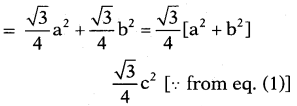
= Area of equilateral triangle on the hypotenuse.
Hence Proved.
Question 2.
Prove that the area of the equilateral triangle described on the side of a square is half the area of the equilateral triangles described on its diagonal.
Answer:
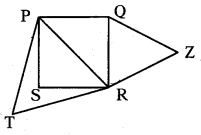
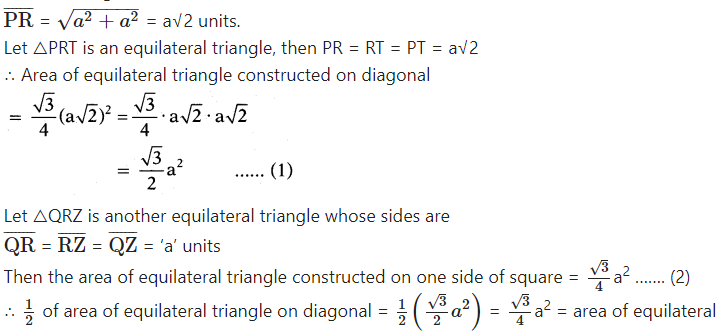
triangle on the side of square.
Hence Proved.
Question 3.
D, E, F are midpoints of sides BC, CA, AB of △ABC. Find the ratio of areas of △DEF and △ABC.
Answer:
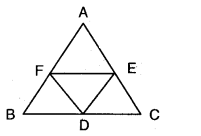
Given in △ABC D, E, F are the midpoints of the sides BC, CA and AB.
In △ABC, EF is the line join of mid-points of two sides AB and AC of △ABC.
Thus FE ‖ BC [∵ AF/FB = AE/EC Converse of B.P.T.]
Similarly DE divides AC and BC in the same ratio, i.e., DE ‖ AB.
Now in □ BDEF, both pairs of opposite sides (BD ‖ EF and DE ‖ BF) are parallel.
Hence □ BDEF is a parallelogram where DF is a diagonal.
∴ △BDF ≃ △DEF ……… (1)
Similarly we can prove that
△DEF ≃ △CDE ……… (2)
[∵ CDFE is a parallelogram]
Also, △DEF ≃ △AEF …….. (3)
[∵ □ AEDF is a parallelogram]
From (1), (2) and (3)
△AEF ≃ △DEF ≃ BDF ≃ △CDE
Also, △ABC = △AEF + △DEF + △BDF + △CDE = 4 . △DEF
Hence, △ABC : △DEF = 4 : 1.
Question 4.
In △ABC, XY ‖ AC and XY divides the triangle into two parts of equal area. Find the ratio of AX/XB.
Answer:
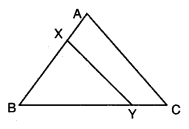
Given: In ∠ABC, XY ‖ AC.
XY divides ∠ABC into two points of equal area.
In ∠ABC, ∠XBY
∠B = ∠B
∠A = ∠X
∠C = ∠Y
[∵ XY ‖ AC; (∠A, ∠X) and ∠C, ∠Y are the pairs of corresponding angles]
Thus ∠ABC ~ ∠XBY by A.A.A similarity condition.
Hence △ABC/△XBY=AB2/XB2
[∵ The ratio of areas of two similar triangles is equal to the ratio of squares of their corresponding sides]
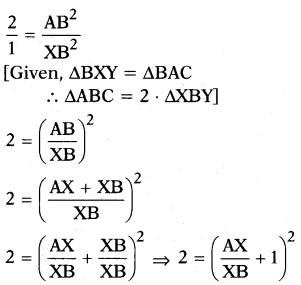
⇒ AX/XB + 1 = √2
⇒ AX/XB = √2 - 1
Hence the ratio AX/XB = √2-1/1.
Question 5.
Prove that the ratio of areas of two similar triangles is equal to the square of the ratio of their corresponding medians.
Answer:

Given: △ABC ~ △XYZ
R.T.P: △ABC/△XYZ = AD2/XW2
Proof : We know that the ratio of areas of two similar triangles is equal to the ratio of the squares of their corresponding sides.
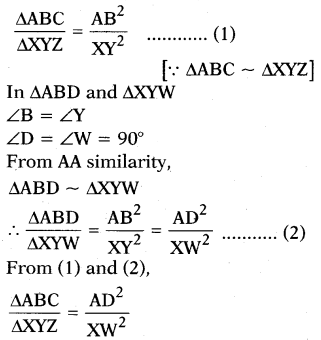
Hence the ratio of areas of two similar triangles is equal to the squares of ratio of their corresponding medians.
Question 6.
△ABC ~ △DEF. BC = 3 cm, EF = 4 cm and area of △ABC = 54 cm2. Determine the area of △DEF.
Answer:
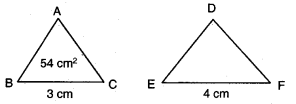
Given: △ABC ~ △DEF
BC = 3 cm
EF = 4 cm
△ABC = 54 cm2
∴ △ABC ~ △DEF, we have
△ABC/△DEF=BC2/EF2
[∵ The ratio of two similar triangles is equal to the ratio of the squares of the corresponding sides].
54/△DEF=32/42
∴ △DEF =54×16/9= 96 cm2
Question 7.
ABC is a triangle and PQ is a straight line meeting AB in P and AC in Q. If AP = 1 cm and BP = 3 cm, AQ =1.5 cm, CQ = 4.5 cm. Prove that area of △APQ = 1/16 (area of △ABC).
Answer:
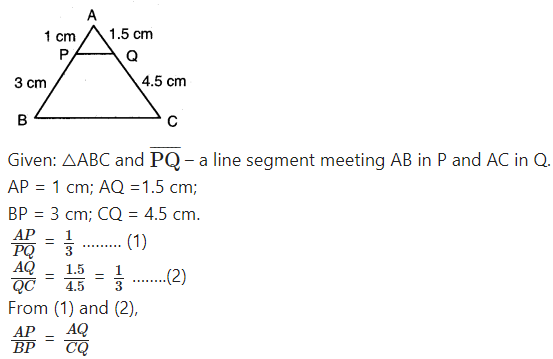
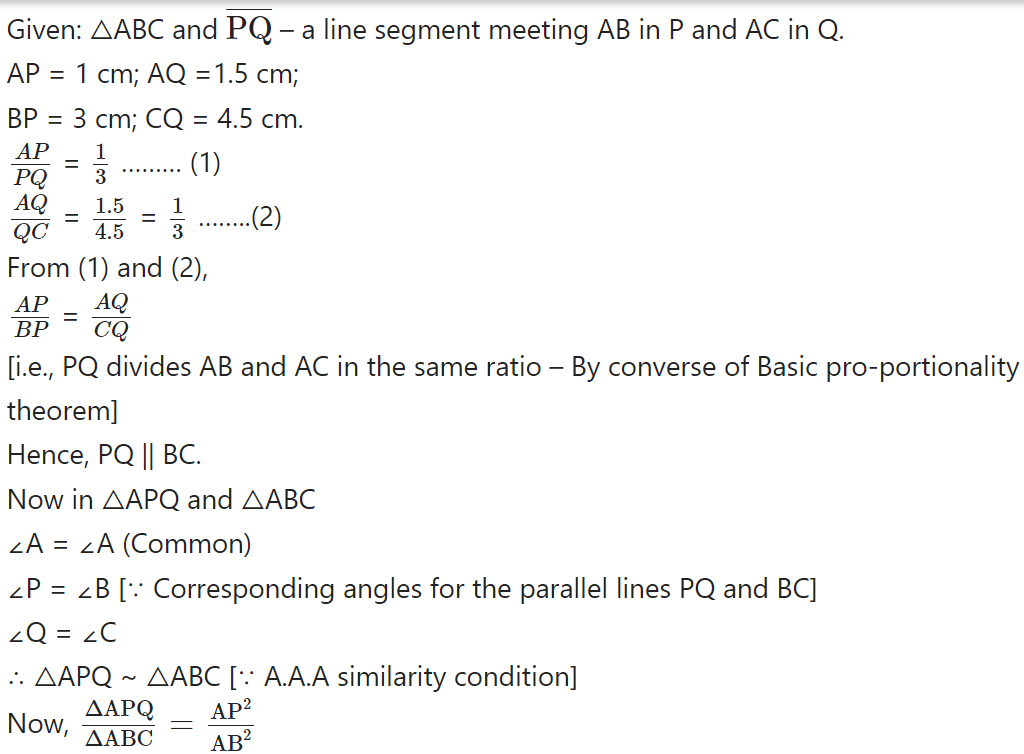
[∵ Ratio of two similar triangles is equal to the ratio of the squares of their corresponding sides].
= 12/(3+1)2 = 1/16 [∵ AB = AP + BP = 1 + 3 = 4 cm]
∴ △APQ = 1/16 (area of △ABC) [Q.E.D]
Question 8.
The areas of two similar triangles are 81 cm2and 49 cm2respectively. If the altitude of the bigger triangle is 4.5 cm. Find the corresponding altitude of the smaller triangle.
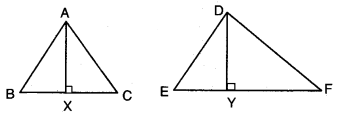
Answer:
Given: △ABC ~ △DEF
△ABC = 81 cm2
△DEF = 49 cm2
AX = 4.5 cm
To find: DY
We know that,
△ABC/△DEF=AX2/DY2
[∵ Ratio of areas of two similar triangles is equal to ratio of the squares of their corresponding altitudes]
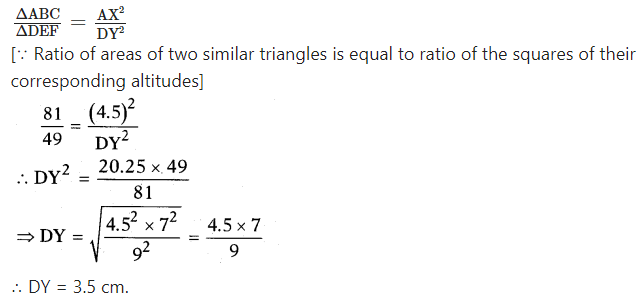
∴ DY = 3.5 cm.
Question 1.
Prove that the sum of the squares of the sides of a rhombus is equal to the sum of the squares of its diagonals.
Answer:
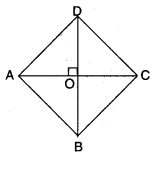
Given : □ ABCD is a rhombus.
Let its diagonals AC and BD bisect each other at ‘O’.
We know that “the diagonals in a rhombus are perpendicular to each other”.
In △AOD; AD2= OA2+ OD2………. (1)
[Pythagoras theorem]
In △COD; CD2= OC2+ OD2………. (2)
[Pythagoras theorem]
In △AOB; AB2= OA2+ OB2………. (3)
[Pythagoras theorem]
In △BOC; BC2= OB2+ OC2………. (4)
[Pythagoras theorem]
Adding the above equations we get AD2+ CD2+ AB2+ BC2= 2 (OA2+ OB2 + OC2+ OD2)
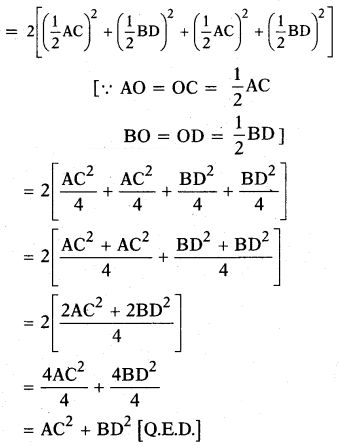
Question 2.
ABC is a right triangle right angled at B. Let D and E be any points on AB and BC respectively. Prove that AE2+ CD2= AC2+ DE2.
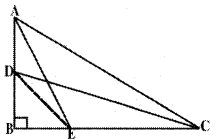
Answer:
Given: In △ABC; ∠B = 90°
D and E are points on AB and BC.
R.T.P.: AE2+ CD2= AC2+ DE2
Proof: In △BCD, △BCD is a right triangle right angled at B.
∴ BD2+ BC2= CD2……… (1)
[∵ Pythagoras theorem states that hypotenuse2= side2+ side2]
In △ABE; ∠B = 90°
Adding (1) and (2), we get
BD2+ BC2+ AB2+ BE2 CD2+ AE2
(BD2+ BE2) + (AB2+ BC2) = CD2+ AE2
DE2+ AC2 - CD2+ AE2[Q.E.D.]
[∵ (i) In △DBE, ∠B = 90° and DE2= BD2+ BE2
(ii) In △ABC, ∠B = 90° and AB2+ BC2]
Question 3.
Prove that three times the square of any side of an equilateral triangle is equal to four times the square of the altitude.
Answer:
Given: △ABC, an equilateral triangle;
AD - altitude and the side is a units, altitude h units.
R.T.P: 3a2= 4h2
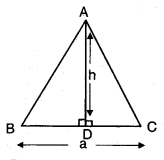
Proof: In △ABD, △ACD
∠B = ∠C [∵ 60°]
∠ADB = ∠ADC [∵ 90°]
∴ ∠BAD = ∠DAC [∵ Angle sum property]
Also, BA = CA
∴ △ABD s △ACD (by SAS congruence condition)
Hence, BD = CD = 1/2 BC = a/2 [∵ c.p.c.t]
Now in △ABD, AB2= AD2+ BD2
[∵ Pythagoras theorem]
a2= h2+(a/2)2
a2= h2+a2/4
h2=4a2-a2/4
∴ h2=3a2/4
⇒ 4h2= 3a2(Q.E.D)
Question 4.
PQR is a triangle right angled at P and M is a point on QR such that PM ⊥ QR. Show that PM2 = QM . MR.
Answer:
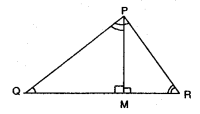
Given: In △PQR, ∠P = 90° and PM ⊥ QR.
R.T.P : PM2 = QM . MR
Proof: In △PQR; △MPR
∠P = ∠M [each 90°]
∠R = ∠R [common]
∴ △PQR ~ △MPR ……… (1)
[A.A. similarity]
In △PQR and △MQP,
∠P = ∠M (each 90°)
∠Q = ∠Q (common)
∴ △PQR ~ △MQP ……… (2)
[A.A. similarity]
From (1) and (2),
△PQR ~ △MPR ~ △MQP [transitive property]
∴ △MPR ~ △MQP
MP/MQ = PR/QP = MR/MP
[Ratio of corresponding sides of similar triangles are equal]
PM/QM = MR/PM
PM . PM = MR . QM
PM2 = QM . MR [Q.E.D]
Question 5.
ABD is a triangle right angled at A and AC ⊥ BD.
Show that (i) AB2= BC BD
(ii) AD2= BD CD
(iii) AC2= BC DC.
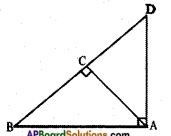
Answer:
Given: In △ABD; ∠A = 90° AC ⊥ BD
R.T.P.:
i) AB2= BC . BD
Proof: In △ABD and △CAB,
∠BAD = ∠ACB [each 90°]
∠B = ∠B [common]
∴ △ABD ~ △CBA
[by A.A. similarity condition]
Hence,AB/BC = BD/AB = AD/AC
[∵ Ratios of corresponding sides of similar triangles are equal]
AB/BD=BC/AB
⇒ AB . AB = BC . BD
∴ AB2= BC . BD
ii) AD2= BD . CD
Proof: In △ABD and △CAD
∠BAD = ∠ACD [each 90°]
∠D = ∠D (common)
∴ △ABD ~ △CAD [A.A similarity]
Hence,AB/AC = BD/AD = AD/CD
⇒ BD/AD = AD/CD
AD . AD = BD . CD
AD2= BD . CD [Q.E.D]
iii) AC2= BC . DC
Proof: From (i) and (ii)
△ACB ~ △DCA
[∵ △BAD ~ △BCA ~ △ACD
Hence,AC/DC = BC/AC = AB/AD
AC/DC=BC/AC
AC . AC = BC . DC
AC2= BC . DC [Q.E.D]
Question 6.
ABC is an isosceles triangle right angled at C. Prove that AB2= 2AC2.
Answer:
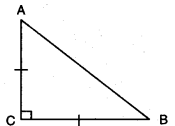
Given: In △ABC; ∠C = 90°; AC = BC.
R.T.P.: AB2= 2AC2
Proof: In △ACB; ∠C = 90°
Hence, AC2+ BC2= AB2
[Square of the hypotenuse is equal to sum of the squares of the other two sides - Pythagoras theorem]
⇒ AC2+ AC2 = AB2[∵ AC = BC given]
⇒ AB2= 2AC2 [Q.E.D.]
Question 7.
‘O’ is any point in the interior of a triangle ABC.
OD ⊥ BC, OE ⊥ AC and OF ⊥ AB, show that
i) OA2+ OB2+ OC2- OD2- OE2- OF2= AF2+ BD2+ CE2
ii) AF2+ BD2+ CE2= AE2+ CD2+ BF2.
Answer:
Given: △ABC; O’ is an interior point of △ABC.
OD ⊥ BC, OE ⊥ AC, OF ⊥ AB.
R.T.P.:
i) OA2+ OB2+ OC2- OD2- OE2- OF2= AF2+ BD2+ CE2
Proof: In OAF, OA2= AF2+ OF2[Pythagoras theorem]
⇒ OA2- OF2= AF2…….. (1)
In △OBD,
OB2= BD2+ OD2
⇒ OB2- OD2= BD2…….. (2)
In △OCE, OC2= CE2+ OE2
OC2- OE2= CE2……… (3)
Adding (1), (2) and (3) we get,
OA2- OF2+ OB2- OD2+ OC2- OE2= AF2+ BD2+ CE2
OA2+ OB2+ OC2- OD2- OE2- OF2= AF2+ BD2+ CE2……… (4)
ii) AF2+ BD2+ CE2= AE2+ CD2+ BF2
In △OAE,
OA2= AE2+ OF2……… (1)
⇒ OA2- OE2= AE2
In △OBF, OB2= BF2+ OF2
OB2- OF2= BF2……… (2)
In △OCD, OC2= OD2+ CD2
OC2- OD2= CD2……… (3)
Adding (1), (2) and (3) we get
OA2- OE2+ OB2- OF2+ OC2- OD2= AE2+ BF2+ CD2
⇒ OA2+ OB2+ OC2- OD2- OE2- OF2= AE2+ CD2+ BF2
⇒ AF2+ BD2+ CE2= AE2+ CD2+ BF2[From problem (i)]
Question 8.
A wire attached to vertical pole of height 18 m is 24 m long and has a stake attached to the other end. How far from the base of the pole should the stake be driven so that the wire will be taut?
Answer:
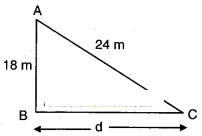
Height of the pole AB = 18 m.
Length of the wire AC = 24 m.
Distance beween the pole and the stake be ‘d’ meters.
By Pythagoras theorem,
Hypotenuse2= side2+ side2
242= 182+ d2
d2= 242- 182= 576 - 324 = 252
= √36×7
∴ d = 6√7 m.
Question 9.
Two poles of heights 6 m and 11m stand on a plane ground. If the distance between the feet of the poles is 12 m, find the distance between their tops.
Answer:
Let the height of the first pole AB = 6 m.
Let the height of the second pole CD = 11 m.
Distance between the poles AC = 12 m.
From the figure □ ACEB is a rectangle.
∴ AB = CE = 6 m
ED = CD - CE = 11 - 6 = 5 m
Now in △BED; ∠E = 90°; DE = 5 m; BE = 12 m
BD2= BE2+ DE2
[hypotenuse2= side2+ side2 - Pythagoras theorem]
= 122+ 52
= 144 + 25
BD2= 169
BD = √l69 = 13m
∴ Distance between the tops of the poles = 13 m.
Question 10.
In an equilateral triangle ABC, D is a point on side BC such that BD = 1/3 BC. Prove that 9AD2 = 7AB2.
Answer:
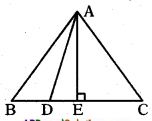
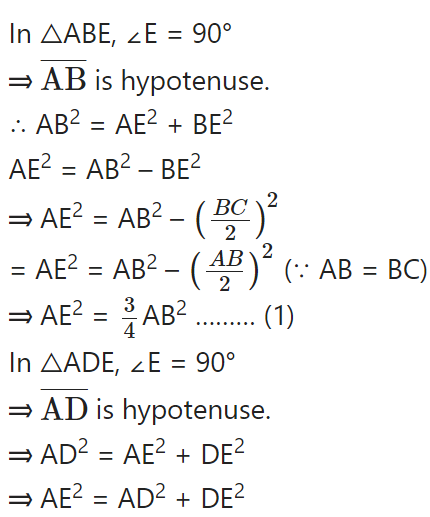
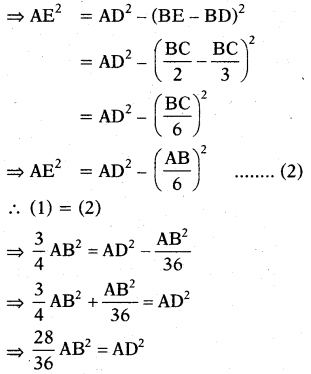
⇒ 28 AB2= 36 AD2
⇒ 7 AB2= 9 AD2
Hence proved.
Question 11.
In the given figure, ABC is a triangle right angled at B. D and E are points on BC trisect it. Prove that 8 AE2= 3 AC2+ 5 AD2.
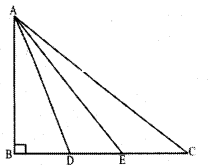
Answer:
In △ABC, ∠B=90°
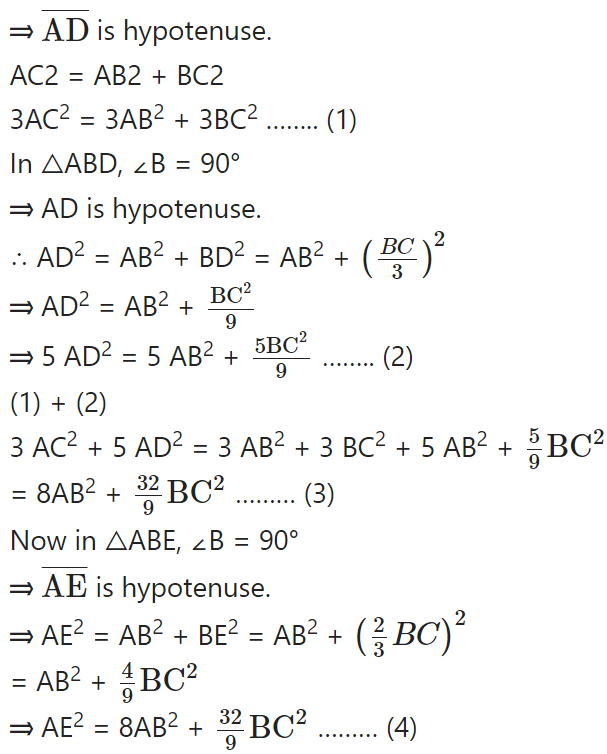
∴ RHS of (3) and (4) are equal.
∴ LHS of (3) and (4) are equal.
∴ 8 AE2 = 3 AC2 + 5 AD2.
Hence proved.
Question 12.
ABC is an isosceles triangle right angled at B. Equilateral triangles ACD and ABE are constructed on sides AC and AB. Find the ratio between the areas of △ABE and △ACD.
Answer:
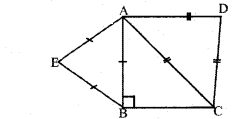
Given: △ABC, AB = BC and ∠B = 90°
△ABE on AB; △ACD on AC are equiangular triangles.
Let equal sides of the isosceles right triangle, AB = BC = a (say)
Then, in △ABC, ∠B = 90°
AC2- AB2+ BC2
[hypotenuse2 = side2+ side2- Pythagoras theorem] = a2+ a2= 2a2
Since, △ABE ~ △ACD
△ABE/△ACD=AB2/AC2
[∵ Ratio of areas of two similar tri-angles is equal to the ratio of squares of their corresponding sides]
=a2/2a2= 1/2
△ABE : △ACD = 1 : 2.